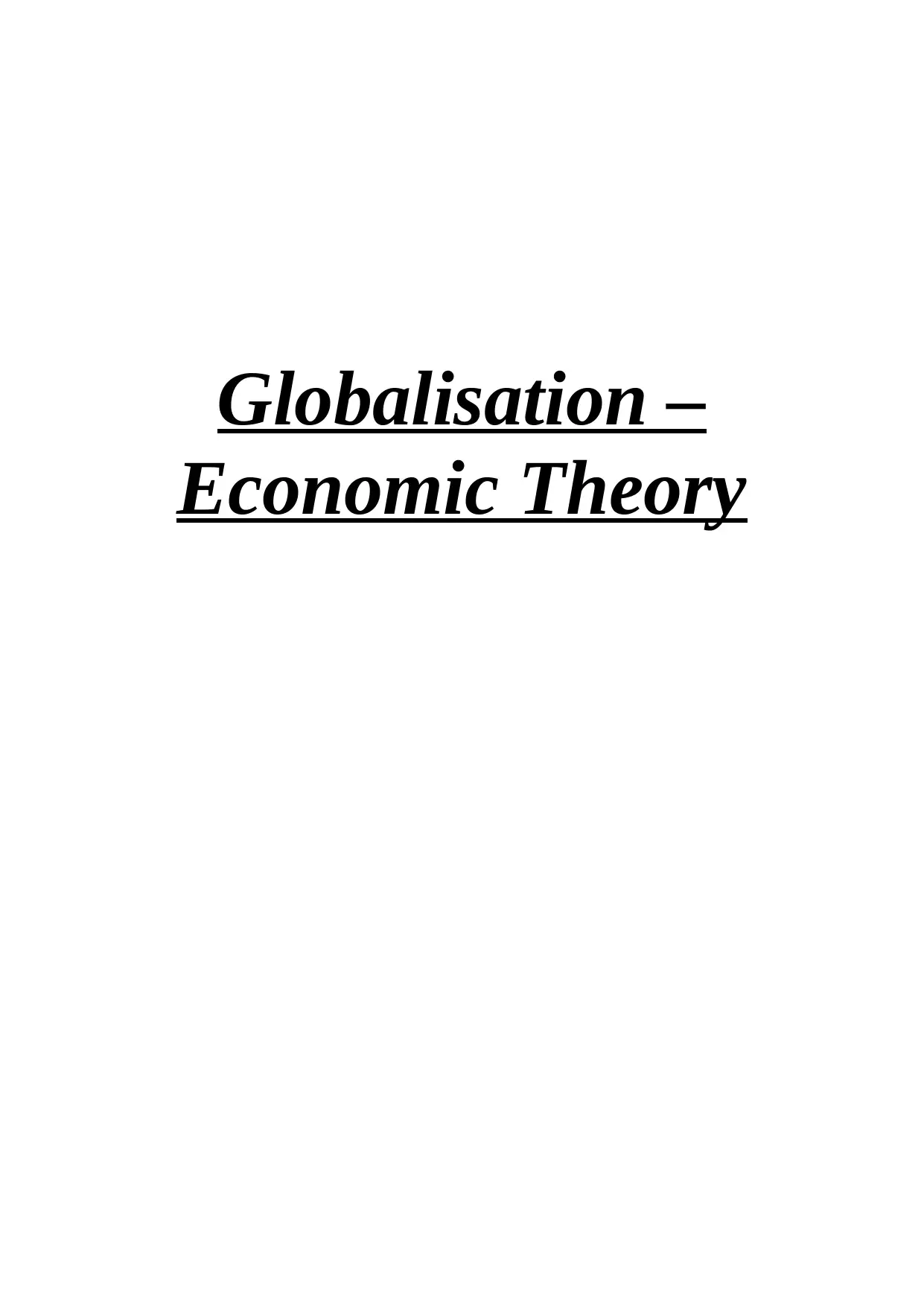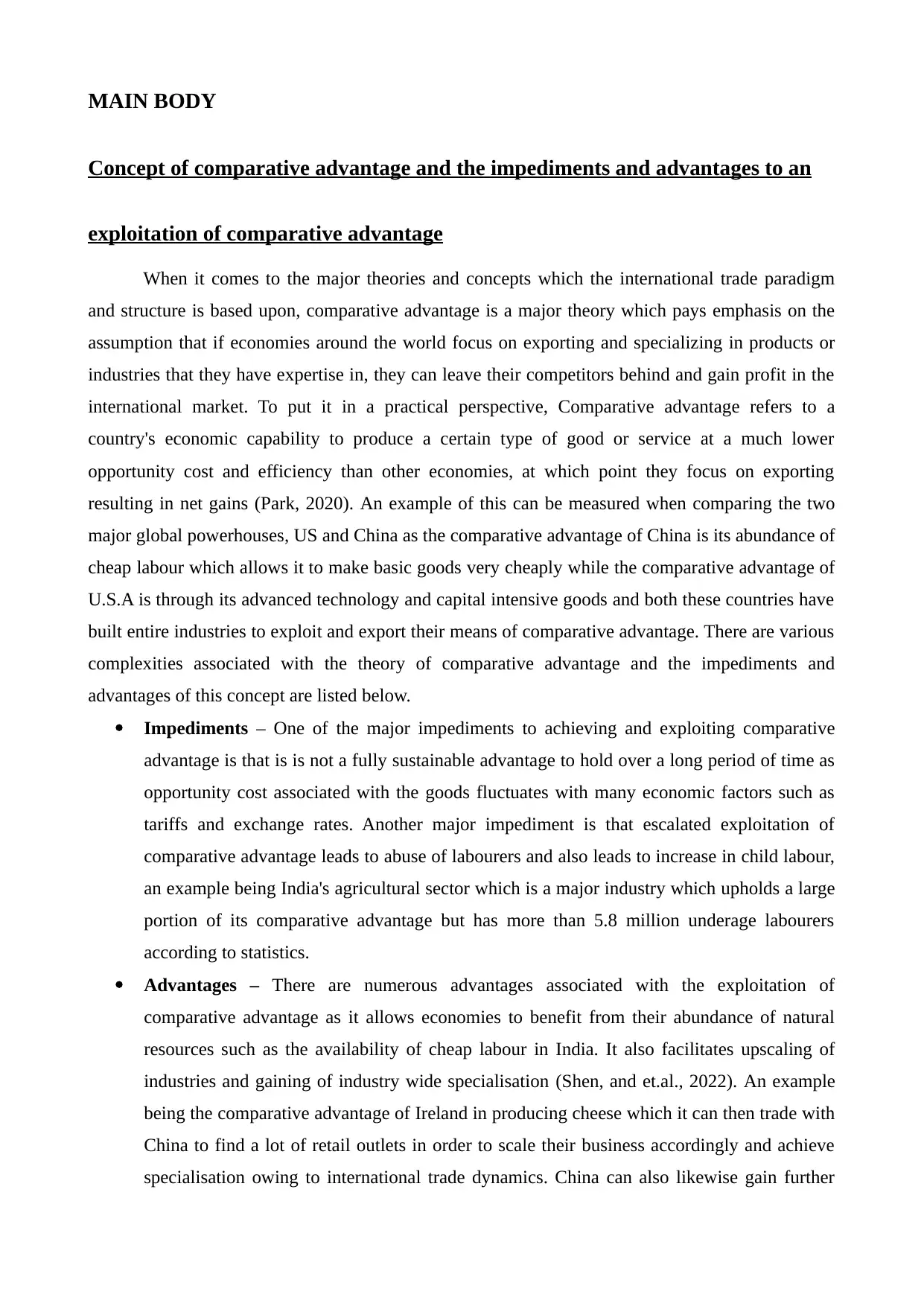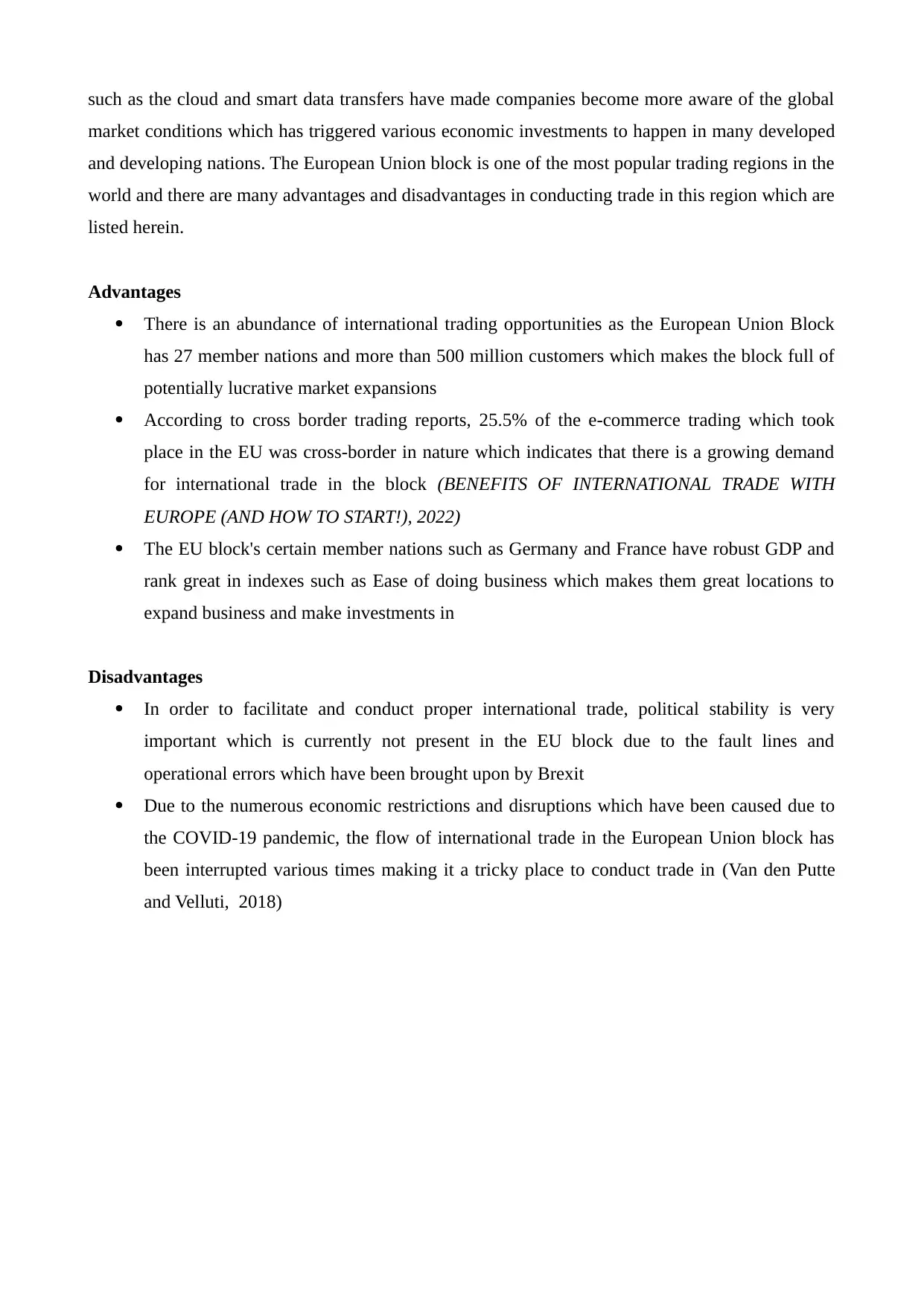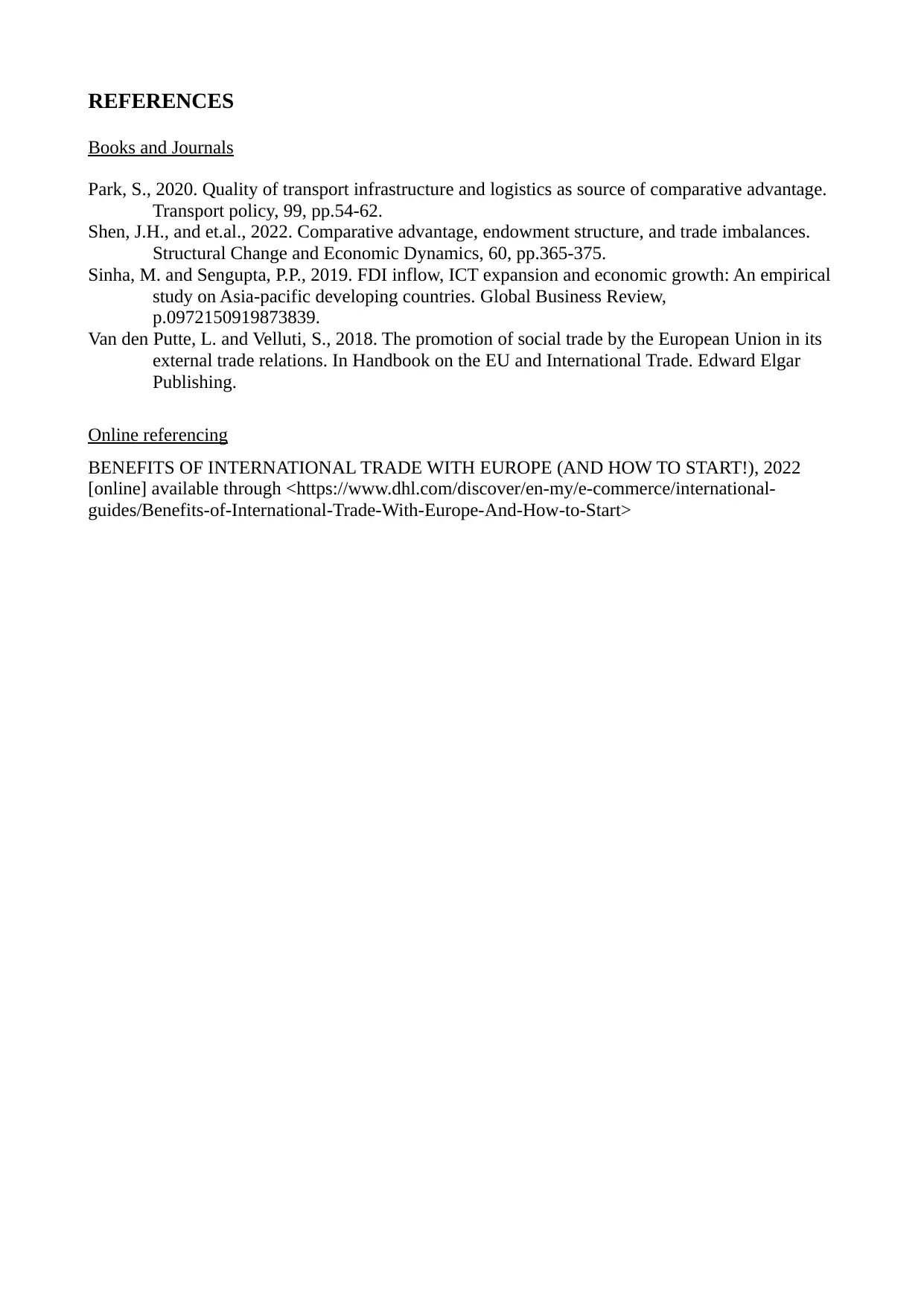Economic Theory of Globalisation and International Trade Report
VerifiedAdded on 2023/06/10
|6
|1339
|461
Report
AI Summary
This report examines key aspects of globalisation through an economic lens. It begins by explaining the concept of comparative advantage, detailing its advantages (such as industry specialization and leveraging natural resources) and impediments (including fluctuating opportunity costs and potential labor abuse), with examples from the US, China, and Ireland. The report then analyzes the factors influencing Foreign Direct Investment (FDI), including political instability, economic disruptions, market size, and globalization trends. Finally, it assesses the rise of international trade, linking it to globalization and technological advancements, and discusses the advantages (market opportunities and e-commerce growth) and disadvantages (political instability and economic disruptions) of trading within the European Union block.

Globalisation –
Economic Theory
Economic Theory
Paraphrase This Document
Need a fresh take? Get an instant paraphrase of this document with our AI Paraphraser

Table of Contents
INTRODUCTION................................................................................................................................3
MAIN BODY ......................................................................................................................................3
CONCLUSION ...................................................................................................................................3
REFERENCES ....................................................................................................................................3
INTRODUCTION................................................................................................................................3
MAIN BODY ......................................................................................................................................3
CONCLUSION ...................................................................................................................................3
REFERENCES ....................................................................................................................................3

MAIN BODY
Concept of comparative advantage and the impediments and advantages to an
exploitation of comparative advantage
When it comes to the major theories and concepts which the international trade paradigm
and structure is based upon, comparative advantage is a major theory which pays emphasis on the
assumption that if economies around the world focus on exporting and specializing in products or
industries that they have expertise in, they can leave their competitors behind and gain profit in the
international market. To put it in a practical perspective, Comparative advantage refers to a
country's economic capability to produce a certain type of good or service at a much lower
opportunity cost and efficiency than other economies, at which point they focus on exporting
resulting in net gains (Park, 2020). An example of this can be measured when comparing the two
major global powerhouses, US and China as the comparative advantage of China is its abundance of
cheap labour which allows it to make basic goods very cheaply while the comparative advantage of
U.S.A is through its advanced technology and capital intensive goods and both these countries have
built entire industries to exploit and export their means of comparative advantage. There are various
complexities associated with the theory of comparative advantage and the impediments and
advantages of this concept are listed below.
Impediments – One of the major impediments to achieving and exploiting comparative
advantage is that is is not a fully sustainable advantage to hold over a long period of time as
opportunity cost associated with the goods fluctuates with many economic factors such as
tariffs and exchange rates. Another major impediment is that escalated exploitation of
comparative advantage leads to abuse of labourers and also leads to increase in child labour,
an example being India's agricultural sector which is a major industry which upholds a large
portion of its comparative advantage but has more than 5.8 million underage labourers
according to statistics.
Advantages – There are numerous advantages associated with the exploitation of
comparative advantage as it allows economies to benefit from their abundance of natural
resources such as the availability of cheap labour in India. It also facilitates upscaling of
industries and gaining of industry wide specialisation (Shen, and et.al., 2022). An example
being the comparative advantage of Ireland in producing cheese which it can then trade with
China to find a lot of retail outlets in order to scale their business accordingly and achieve
specialisation owing to international trade dynamics. China can also likewise gain further
Concept of comparative advantage and the impediments and advantages to an
exploitation of comparative advantage
When it comes to the major theories and concepts which the international trade paradigm
and structure is based upon, comparative advantage is a major theory which pays emphasis on the
assumption that if economies around the world focus on exporting and specializing in products or
industries that they have expertise in, they can leave their competitors behind and gain profit in the
international market. To put it in a practical perspective, Comparative advantage refers to a
country's economic capability to produce a certain type of good or service at a much lower
opportunity cost and efficiency than other economies, at which point they focus on exporting
resulting in net gains (Park, 2020). An example of this can be measured when comparing the two
major global powerhouses, US and China as the comparative advantage of China is its abundance of
cheap labour which allows it to make basic goods very cheaply while the comparative advantage of
U.S.A is through its advanced technology and capital intensive goods and both these countries have
built entire industries to exploit and export their means of comparative advantage. There are various
complexities associated with the theory of comparative advantage and the impediments and
advantages of this concept are listed below.
Impediments – One of the major impediments to achieving and exploiting comparative
advantage is that is is not a fully sustainable advantage to hold over a long period of time as
opportunity cost associated with the goods fluctuates with many economic factors such as
tariffs and exchange rates. Another major impediment is that escalated exploitation of
comparative advantage leads to abuse of labourers and also leads to increase in child labour,
an example being India's agricultural sector which is a major industry which upholds a large
portion of its comparative advantage but has more than 5.8 million underage labourers
according to statistics.
Advantages – There are numerous advantages associated with the exploitation of
comparative advantage as it allows economies to benefit from their abundance of natural
resources such as the availability of cheap labour in India. It also facilitates upscaling of
industries and gaining of industry wide specialisation (Shen, and et.al., 2022). An example
being the comparative advantage of Ireland in producing cheese which it can then trade with
China to find a lot of retail outlets in order to scale their business accordingly and achieve
specialisation owing to international trade dynamics. China can also likewise gain further
⊘ This is a preview!⊘
Do you want full access?
Subscribe today to unlock all pages.

Trusted by 1+ million students worldwide

specialisation in making cheap electronics by trading them with Ireland in exchange of
importing their cheeses which results in mutual growth.
The reasons behind the rise and fall in Foreign Direct Investment FDI
Foreign direct investment has witnesses a lot of surges and setbacks I the past few decades
as it has numerous drivers which impact it growth on a global level and some reasons behind its fall
and rise are listed herein.
Fall – There are many reasons due to which FDI decreases over time as well such as
political instability and major economic disruptions which deters companies to expand and
invest on a global level. A major example of such reasons are the current civil situation in
Sri Lanka which has made the country starve for more FDI and the overall decrement in
global FDI which has been triggered due to the restrictions and regulations in light of the
COVID-19 pandemic
Rise – FDI has seen major rise in major developing countries due to their potential for
growth and when the host country's market size is extensive and their economic condition
inn healthy, firms expand and bring in FDI in hopes of gaining new lucrative market shares.
Globalization has also been a major reason due to which the level of FDI has seen a major
rise as the ease of cross-border trades has allowed multinational companies all over the
world to expand worldwide in hopes of better profitability (Sinha and Sengupta, 2019)
Assess the rise of international trade and discuss the advantages and
disadvantages of trading in European Union block.
International trade has risen in the past few decades on an astronomical level and this rise
has been closely associated with the advent of globalization. This phenomenon has facilitated the
ease in undertaking cross border trading between nations which has resulted in establishment of
digital and physical exchange channels which is a major contributor to the robust nature of
international trade we get to observe today. Absolute and comparative advantages are also related to
the major growth of international trade as countries are looking to exploit as much of their natural
economic resources as possible such as India and China using their availability of cheap manual
labour to attract major multinational companies and accumulate good amount of Foreign Direct
Investment in the process. The rapid growth of global technology has also been a major driver
which has influenced the rise in international trading as the advances in internet based technologies
importing their cheeses which results in mutual growth.
The reasons behind the rise and fall in Foreign Direct Investment FDI
Foreign direct investment has witnesses a lot of surges and setbacks I the past few decades
as it has numerous drivers which impact it growth on a global level and some reasons behind its fall
and rise are listed herein.
Fall – There are many reasons due to which FDI decreases over time as well such as
political instability and major economic disruptions which deters companies to expand and
invest on a global level. A major example of such reasons are the current civil situation in
Sri Lanka which has made the country starve for more FDI and the overall decrement in
global FDI which has been triggered due to the restrictions and regulations in light of the
COVID-19 pandemic
Rise – FDI has seen major rise in major developing countries due to their potential for
growth and when the host country's market size is extensive and their economic condition
inn healthy, firms expand and bring in FDI in hopes of gaining new lucrative market shares.
Globalization has also been a major reason due to which the level of FDI has seen a major
rise as the ease of cross-border trades has allowed multinational companies all over the
world to expand worldwide in hopes of better profitability (Sinha and Sengupta, 2019)
Assess the rise of international trade and discuss the advantages and
disadvantages of trading in European Union block.
International trade has risen in the past few decades on an astronomical level and this rise
has been closely associated with the advent of globalization. This phenomenon has facilitated the
ease in undertaking cross border trading between nations which has resulted in establishment of
digital and physical exchange channels which is a major contributor to the robust nature of
international trade we get to observe today. Absolute and comparative advantages are also related to
the major growth of international trade as countries are looking to exploit as much of their natural
economic resources as possible such as India and China using their availability of cheap manual
labour to attract major multinational companies and accumulate good amount of Foreign Direct
Investment in the process. The rapid growth of global technology has also been a major driver
which has influenced the rise in international trading as the advances in internet based technologies
Paraphrase This Document
Need a fresh take? Get an instant paraphrase of this document with our AI Paraphraser

such as the cloud and smart data transfers have made companies become more aware of the global
market conditions which has triggered various economic investments to happen in many developed
and developing nations. The European Union block is one of the most popular trading regions in the
world and there are many advantages and disadvantages in conducting trade in this region which are
listed herein.
Advantages
There is an abundance of international trading opportunities as the European Union Block
has 27 member nations and more than 500 million customers which makes the block full of
potentially lucrative market expansions
According to cross border trading reports, 25.5% of the e-commerce trading which took
place in the EU was cross-border in nature which indicates that there is a growing demand
for international trade in the block (BENEFITS OF INTERNATIONAL TRADE WITH
EUROPE (AND HOW TO START!), 2022)
The EU block's certain member nations such as Germany and France have robust GDP and
rank great in indexes such as Ease of doing business which makes them great locations to
expand business and make investments in
Disadvantages
In order to facilitate and conduct proper international trade, political stability is very
important which is currently not present in the EU block due to the fault lines and
operational errors which have been brought upon by Brexit
Due to the numerous economic restrictions and disruptions which have been caused due to
the COVID-19 pandemic, the flow of international trade in the European Union block has
been interrupted various times making it a tricky place to conduct trade in (Van den Putte
and Velluti, 2018)
market conditions which has triggered various economic investments to happen in many developed
and developing nations. The European Union block is one of the most popular trading regions in the
world and there are many advantages and disadvantages in conducting trade in this region which are
listed herein.
Advantages
There is an abundance of international trading opportunities as the European Union Block
has 27 member nations and more than 500 million customers which makes the block full of
potentially lucrative market expansions
According to cross border trading reports, 25.5% of the e-commerce trading which took
place in the EU was cross-border in nature which indicates that there is a growing demand
for international trade in the block (BENEFITS OF INTERNATIONAL TRADE WITH
EUROPE (AND HOW TO START!), 2022)
The EU block's certain member nations such as Germany and France have robust GDP and
rank great in indexes such as Ease of doing business which makes them great locations to
expand business and make investments in
Disadvantages
In order to facilitate and conduct proper international trade, political stability is very
important which is currently not present in the EU block due to the fault lines and
operational errors which have been brought upon by Brexit
Due to the numerous economic restrictions and disruptions which have been caused due to
the COVID-19 pandemic, the flow of international trade in the European Union block has
been interrupted various times making it a tricky place to conduct trade in (Van den Putte
and Velluti, 2018)

REFERENCES
Books and Journals
Park, S., 2020. Quality of transport infrastructure and logistics as source of comparative advantage.
Transport policy, 99, pp.54-62.
Shen, J.H., and et.al., 2022. Comparative advantage, endowment structure, and trade imbalances.
Structural Change and Economic Dynamics, 60, pp.365-375.
Sinha, M. and Sengupta, P.P., 2019. FDI inflow, ICT expansion and economic growth: An empirical
study on Asia-pacific developing countries. Global Business Review,
p.0972150919873839.
Van den Putte, L. and Velluti, S., 2018. The promotion of social trade by the European Union in its
external trade relations. In Handbook on the EU and International Trade. Edward Elgar
Publishing.
Online referencing
BENEFITS OF INTERNATIONAL TRADE WITH EUROPE (AND HOW TO START!), 2022
[online] available through <https://www.dhl.com/discover/en-my/e-commerce/international-
guides/Benefits-of-International-Trade-With-Europe-And-How-to-Start>
Books and Journals
Park, S., 2020. Quality of transport infrastructure and logistics as source of comparative advantage.
Transport policy, 99, pp.54-62.
Shen, J.H., and et.al., 2022. Comparative advantage, endowment structure, and trade imbalances.
Structural Change and Economic Dynamics, 60, pp.365-375.
Sinha, M. and Sengupta, P.P., 2019. FDI inflow, ICT expansion and economic growth: An empirical
study on Asia-pacific developing countries. Global Business Review,
p.0972150919873839.
Van den Putte, L. and Velluti, S., 2018. The promotion of social trade by the European Union in its
external trade relations. In Handbook on the EU and International Trade. Edward Elgar
Publishing.
Online referencing
BENEFITS OF INTERNATIONAL TRADE WITH EUROPE (AND HOW TO START!), 2022
[online] available through <https://www.dhl.com/discover/en-my/e-commerce/international-
guides/Benefits-of-International-Trade-With-Europe-And-How-to-Start>
⊘ This is a preview!⊘
Do you want full access?
Subscribe today to unlock all pages.

Trusted by 1+ million students worldwide
1 out of 6
Related Documents
Your All-in-One AI-Powered Toolkit for Academic Success.
+13062052269
info@desklib.com
Available 24*7 on WhatsApp / Email
![[object Object]](/_next/static/media/star-bottom.7253800d.svg)
Unlock your academic potential
Copyright © 2020–2025 A2Z Services. All Rights Reserved. Developed and managed by ZUCOL.





